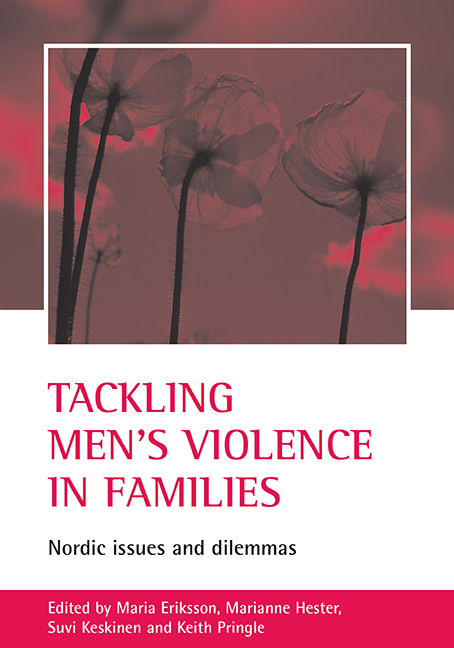Book contents
- Frontmatter
- Contents
- List of tables and figures
- Acknowledgements
- Notes on contributors
- one Introduction: Nordic issues and dilemmas
- two Children, abuse and parental contact in Denmark
- three Commitments and contradictions: linking violence, parenthood and professionalism
- four “Talking feels like you wouldn’t love Dad anymore”: children’s emotions, close relations and domestic violence
- five Bypassing the relationship between fatherhood and violence in Finnish policy and research
- six Marching on the spot? Dealing with violence against women in Norway
- seven Children’s peace? The possibility of protecting children by means of criminal law and family law
- eight A visible or invisible child? Professionals’ approaches to children whose father is violent towards their mother
- nine “Take my father away from home”: children growing up in the proximity of violence
- ten Neglected issues in Swedish child protection policy and practice: age, ethnicity and gender
- eleven Tackling men’s violence in families: lessons for the UK
- References
- Index
one - Introduction: Nordic issues and dilemmas
Published online by Cambridge University Press: 20 January 2022
- Frontmatter
- Contents
- List of tables and figures
- Acknowledgements
- Notes on contributors
- one Introduction: Nordic issues and dilemmas
- two Children, abuse and parental contact in Denmark
- three Commitments and contradictions: linking violence, parenthood and professionalism
- four “Talking feels like you wouldn’t love Dad anymore”: children’s emotions, close relations and domestic violence
- five Bypassing the relationship between fatherhood and violence in Finnish policy and research
- six Marching on the spot? Dealing with violence against women in Norway
- seven Children’s peace? The possibility of protecting children by means of criminal law and family law
- eight A visible or invisible child? Professionals’ approaches to children whose father is violent towards their mother
- nine “Take my father away from home”: children growing up in the proximity of violence
- ten Neglected issues in Swedish child protection policy and practice: age, ethnicity and gender
- eleven Tackling men’s violence in families: lessons for the UK
- References
- Index
Summary
The Nordic countries are characterised by, and internationally famous for, strongly pronounced ideologies of gender equality and childcentredness anchored in legislation and other sources of public norms. They are welfare states where women especially have a relatively strong position in the public sphere. The consensus-oriented Nordic research on gender equality and gender politics has led to substantial improvements within many sectors of these societies. This positive development is, however, not as evident in the area of gender and violence, for example regarding violence and rape against women and girls in intimate relationships. It is clear that a context with strong ideologies of gender equality and child-centredness does not wipe out men's violence against women and children. This fact makes Nordic research especially, and internationally, interesting (Gender and Violence, 2000).
The most recent national surveys on men's violence against women in the Nordic countries indicate that the social problem of men's violence is no less serious in these countries than in other parts of the Western world (Heiskanen and Piispa, 1998; Lundgren et al, 2001). According to the Finnish study, 22% of all married and cohabiting women have at some point been victims of physical or sexual violence or threats of violence by their present partner (9% in the course of the past year) (Heiskanen and Piispa, 1998). In the Swedish study, the comparable figure is 11% (Lundgren et al, 2001). Furthermore, according to the latter study, 35% of separated or divorced women have been exposed to physical or sexual violence or threats of violence by a previous partner (in Finland the comparable figure is 50%).
Today, there is increasing public recognition in all of the Nordic countries of men's violence against women as a social problem. The long-standing political work of voluntary organisations supporting women and children, such as women's helplines, refuges and shelters, has without doubt been central to this development. However, as will be shown in this book, the Nordic countries are different. For example, the development in Finland has followed a different trajectory compared to Norway and Sweden. From the beginning, the explicit aim of the Finnish shelters was to work with the whole family, not only women and children.
- Type
- Chapter
- Information
- Tackling Men's Violence in FamiliesNordic Issues and Dilemmas, pp. 1 - 12Publisher: Bristol University PressPrint publication year: 2005
- 1
- Cited by



